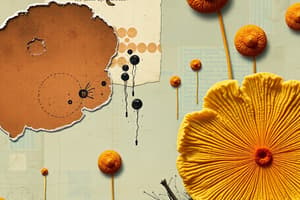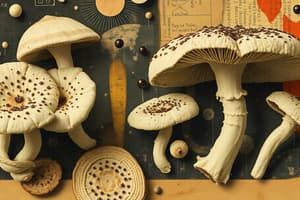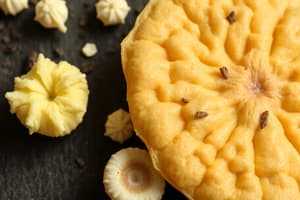Podcast
Questions and Answers
What process do yeast cells primarily use to reproduce?
What process do yeast cells primarily use to reproduce?
- Budding (correct)
- Spore formation
- Binary fission
- Fragmentation
Which characteristic describes the habitat where moulds are commonly found?
Which characteristic describes the habitat where moulds are commonly found?
- Open and sunny fields
- Dry and warm environments
- Cold, icy regions
- Damp, dark or humid areas (correct)
What is the mass of hyphae that forms a mould colony called?
What is the mass of hyphae that forms a mould colony called?
- Pseudohyphae
- Spores
- Filaments
- Mycelium (correct)
What type of spores do moulds produce?
What type of spores do moulds produce?
What type of cellular structure characterizes moulds?
What type of cellular structure characterizes moulds?
Which of the following health risks is commonly associated with mould exposure?
Which of the following health risks is commonly associated with mould exposure?
What color options can moulds be identified by?
What color options can moulds be identified by?
Which of the following statements about hyphae is correct?
Which of the following statements about hyphae is correct?
Which structural form can fungi exist in?
Which structural form can fungi exist in?
What is a common habitat for yeasts?
What is a common habitat for yeasts?
What distinguishes yeasts from true hyphae?
What distinguishes yeasts from true hyphae?
In which condition can yeast grow?
In which condition can yeast grow?
What is a health risk associated with yeast?
What is a health risk associated with yeast?
What is the main component found in fungal cell walls?
What is the main component found in fungal cell walls?
What is the typical appearance of yeasts?
What is the typical appearance of yeasts?
What type of cells are yeasts classified as?
What type of cells are yeasts classified as?
What is one of the main conditions caused by Candida albicans that affects the skin?
What is one of the main conditions caused by Candida albicans that affects the skin?
Which of the following is a mucosal condition caused by an overgrowth of Candida albicans?
Which of the following is a mucosal condition caused by an overgrowth of Candida albicans?
What can cause systemic candidiasis?
What can cause systemic candidiasis?
Which of these factors is NOT a predisposing factor for candidiasis?
Which of these factors is NOT a predisposing factor for candidiasis?
What is a common manifestation of nappy rash caused by Candida albicans?
What is a common manifestation of nappy rash caused by Candida albicans?
What areas of the body are most commonly affected by skin infections from Candida albicans?
What areas of the body are most commonly affected by skin infections from Candida albicans?
Which of the following represents a rare condition associated with Candida infection due to impacted host immune response?
Which of the following represents a rare condition associated with Candida infection due to impacted host immune response?
What role do pathogenicity factors of Candida albicans play in the infection process?
What role do pathogenicity factors of Candida albicans play in the infection process?
What is a characteristic form of yeasts?
What is a characteristic form of yeasts?
Which of the following habitats is most commonly associated with moulds?
Which of the following habitats is most commonly associated with moulds?
Which of these colors can yeasts exhibit?
Which of these colors can yeasts exhibit?
What type of oxygen requirement do yeasts have?
What type of oxygen requirement do yeasts have?
What are true hyphae?
What are true hyphae?
Which of the following health risks is associated with an overgrowth of yeast fungi?
Which of the following health risks is associated with an overgrowth of yeast fungi?
What is a distinguishing feature of moulds compared to yeasts?
What is a distinguishing feature of moulds compared to yeasts?
What defines commensal oral microflora?
What defines commensal oral microflora?
What is the primary mode of transmission for Cryptococcus infections?
What is the primary mode of transmission for Cryptococcus infections?
Which of the following symptoms is NOT commonly associated with systemic fungal infections such as Cryptococcus?
Which of the following symptoms is NOT commonly associated with systemic fungal infections such as Cryptococcus?
What is the treatment for Aspergillosis?
What is the treatment for Aspergillosis?
What complication can arise from a severe Cryptococcus infection?
What complication can arise from a severe Cryptococcus infection?
What is a common habitat for the fungus responsible for causing Zygomycosis?
What is a common habitat for the fungus responsible for causing Zygomycosis?
How can Aspergillosis affect the lungs?
How can Aspergillosis affect the lungs?
Which treatment option is typically NOT used for Zygomycosis?
Which treatment option is typically NOT used for Zygomycosis?
What common factor contributes to the development of systemic fungal infections?
What common factor contributes to the development of systemic fungal infections?
Study Notes
Fungi: Yeast vs. Mould
- Fungi are eukaryotic organisms.
- Candida is a significant fungus in dentistry.
- Fungi exist in two forms: yeast (single-celled) and mould (multicellular).
- Some fungi are dimorphic (can be both yeast and mould).
- Fungi cell walls contain chitin.
Yeast Characteristics
- Grow as single, large cells.
- Unicellular.
- Found on fruits, in the digestive tract, oral cavity, and vagina.
- Appear white and thread-like, usually oval.
- Lack true hyphae; instead, form pseudohyphae (chains of elongated budding cells).
- Not a spore-forming species.
- Color varies but is generally less vibrant than moulds (white, cream, pink).
- Can grow aerobically or anaerobically.
- Overgrowth can cause infections (candidiasis).
- Reproduce asexually by budding or binary fission.
Mould Characteristics
- Grow as multiple tubular branches forming filaments.
- Multicellular.
- Found in damp, dark, or humid environments.
- Appear fuzzy and come in many shapes and colors.
- Possess microscopic filaments called hyphae.
- A spore-forming fungus.
- Colors are diverse (red, green, black, brown, pink, purple).
- Grow only aerobically.
- Can trigger allergic reactions and respiratory problems.
- Hyphae form a mass called mycelium.
- Reproduce through spores (asexual or sexual).
Fungal Commensal Flora
- Fungi live on skin and mucosal surfaces.
- Interact with the immune system.
- Locations include skin (Candida albicans), oral cavity (Malassezia), and other mucosal surfaces.
Candida albicans Infections
- Causes superficial yeast infections (skin).
- Causes mucosal infections (thrush) in the mouth: characterized by a cottony feeling mouth, white coating on tongue, white spots, and taste loss.
- Candidiasis can affect the skin (especially in areas with skin-to-skin contact) and nails (paronychia).
- Mucocutaneous candidiasis involves skin and oral/vaginal mucosa.
- Systemic candidiasis (deep candidiasis resulting from candidaemia) can be fatal if untreated affecting various organs including the endocardium, meninges, bones and kidneys.
- Predisposing factors: decreased digestive secretions, nutrient deficiencies, impaired immune system, underlying diseases, impaired liver function, drug use (especially prolonged antibiotic use), and altered bowel flora.
Systemic Fungal Infections
Cryptococcus
- Caused by inhaling spores from Cryptococcus yeast.
- Found in soil.
- Transmission via inhalation.
- Symptoms include fever, headache, malaise, neck stiffness, and can lead to meningitis or lung infection.
- Treatment involves antifungal medication (e.g., fluconazole or flucytosine).
Aspergillosis
- Caused by inhaling spores of the Aspergillus mould.
- Found in plants, decaying matter, soil, air, and water.
- Transmission by inhalation.
- Symptoms range from allergic reactions to bleeding in the lungs, localized infections, and potentially more severe conditions such as endocarditis, endophthalmitis, and even cerebral aspergillosis.
- Treatment involves corticosteroids and antifungal medication (oral or intravenous).
Zygomycosis
- Caused by Zygomycota fungi found in soil, decaying organic matter, and air.
- Transmission via inhalation, ingestion, or inoculation through trauma.
- Can cause rhinocerebral and pulmonary disease.
- Treatment involves antifungal medication and potentially surgery.
Studying That Suits You
Use AI to generate personalized quizzes and flashcards to suit your learning preferences.
Related Documents
Description
This quiz will test your knowledge on the characteristics of two major forms of fungi: yeast and mould. It covers their biological structure, reproduction methods, and significance in various environments, particularly in relation to human health. Understand the differences between these eukaryotic organisms and their roles in nature and medicine.




